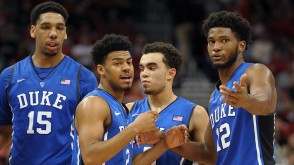The Specter of O’Bannon over March Madness
March Madness came to an end with the Duke Blue Devils victorious over the Wisconsin Badgers in a hotly contested finale. This year’s tournament was also notable for netting the highest ratings in the last 22 years, with 33.4 million viewers watching the championship game. The success of the tournament, however, belies a number of issues currently hanging a cloud over the NCAA. There are increasing calls for the NCAA to reform its policy of not paying its college athletes a salary and its stringent restrictions on any form of athlete compensation. In an episode that aired the week before the beginning of March Madness, the comedian John Oliver played a clip of NCAA President Mark Emmert repeating multiple times that college athletes are students, not employees. Oliver quipped, “the only other people who say ‘they’re not employees’ that much are people who run illegal sweatshops out of their basements.”
The NCAA has more problems than being butt of late night jokes though. Recent administrative and judicial decisions have begun chipping away at the NCAA’s grip over its athletes. The regional National Labor Relations Board Director recently held that the scholarship football players at Northwestern University were indeed employees and therefore permitted to unionize under the National Labor Relations Act. And last August, a US district court held that the NCAA’s use of athletes’ names, images, and likenesses (NILs) without paying compensation was a violation of antitrust law. This case was O’Bannon v. NCAA, and it’s seen as a significant sea change for the NCAA.
The lead plaintiff of the lawsuit, Edward O’Bannon, played basketball for the UCLA Bruins and was the starting power forward for the team when they won the championship in 1995. O’Bannon has not played in the NCAA since 1995, two decades ago, yet the NCAA still capitalizes on his image in NCAA-branded video games and pays him no compensation. The O’Bannon plaintiffs argued that the NCAA’s rules harmed current and former athletes by depriving them of payment. At the end of the five-year suit, the district court held that the NCAA did restrict competition among its members (one of the NCAA’s own economic experts referred to the NCAA as a ‘cartel’) and these anti-competitive practices harmed athletes. The court, however, disagreed that the harm was caused by anti-competitive constraints in the sale of group licenses to TV networks. This still leaves open the possibility of legal action against TV networks for use of athletes’ NILs.
The court in O’Bannon also issued an injunction preventing the NCAA from enforcing bylaws that would prohibit its member schools from offering their FBS football or Division I basketball recruits a limited share of the revenues generated from the use of their NILs. The NCAA is permitted to cap any revenue paid to college athletes at $5000 per year, and the money would be placed in a trust fund, available to the athlete after graduation or termination of his college athletic career. Individual schools may choose not to offer athletes any share of their revenue, but schools are not allowed to collude in lowering the amount they offer. The injunction in the O’Bannon decision opens the door to paying college athletes a fraction of the billions of dollars they generate for their schools.
The O’Bannon decision is remarkable in that it is the first court decision that takes down the defense of amateurism that the NCAA has relied on for the last several decades. While the NCAA refers to its players as student-athletes, a shining epitome of amateurism in college sports, the NCAA’s defense of amateurism has an ignominious history. The first NCAA President coined the term student-athlete in order to avoid paying athletes’ worker compensation claims. The NCAA launched a concerted public relations campaign to promote the term and was wildly successful – courts have consistently denied workers’ compensation claims brought by severely injured college athletes since the 1960s. The current reality though, recognized by the court in O’Bannon, is that college sports is a massively lucrative business, which stands in stark contrast to the amateur model the NCAA says it espouses.
Whether the gains by the O’Bannon plaintiffs will translate into other aftershocks for the NCAA amateur model remains to be seen. The NCAA is appealing O’Bannon to the Ninth Circuit. The district court injunction will remain in effect, however, until the Court of Appeals chooses to strike it down. A number of lawsuits on the issue of paying players are also waiting in the wings for the NCAA, and the plaintiffs in those suits will undoubtedly look to the language in O’Bannon for support. This year’s March Madness may have served as a welcome success for the NCAA, but the league faces significant challenges ahead to what some call it’s antiquated collegiate model. The O’Bannon decision will hang over the NCAA for years to come.


Leave a Reply